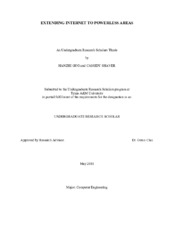| dc.creator | Guo, Hanzhi | |
| dc.creator | Shaver, Cassidy | |
| dc.date.accessioned | 2018-05-23T15:34:58Z | |
| dc.date.available | 2018-05-23T15:34:58Z | |
| dc.date.created | 2019-05 | |
| dc.date.submitted | May 2019 | |
| dc.identifier.uri | https://hdl.handle.net/1969.1/166498 | |
| dc.description.abstract | Literature Review
The lack of internet in undeveloped countries and other rural areas is detrimental to the development of the area. Access to internet can have many profound effects on developing countries such as creating economic opportunities for small and medium sized businesses (Meltzer) and improving education (Purdue). In many of these rural areas and developing countries, such as Africa, children do not have up to date education (The Economist), people struggle to find jobs (ACET), and the infrastructure is lacking (The World Bank).
The lack of internet in areas that have been affected by natural disasters is also a large problem that our society faces. Areas where the cellular towers and power generators were knocked out would benefit greatly from connectivity because it would allow the affected community to communicate with outside help. One example of when internet needed to be extended to an area affected by disaster is Puerto Rico after Hurricane Irma knocked out over 90% of their cell service (Fiegerman).
Some companies have attempted to create solar powered wi-fi hotspots, but none of them are implemented in the way that we plan to solve the problem. No product exists that can provide internet without cellular coverage nor a power grid. However, there are a couple of products that are in our area of research. The company Soluxio has created a solar powered wi-fi extender/LTE wi-fi hotspot. This is primarily for creating outdoor wi-fi networks in places with an existing internet connection or for resorts and city parks in developed areas where LTE data is available (Soluxio). The company Moja has created a microserver that also connects to LTE data. This device has the option to be solar powered, but it also has the same limitation as the Soluxio device in that it relies on LTE data which does not cover a large portion of the globe (Moja).
Thesis Statement
Design a system/device that can provide internet to areas that do not have reliable power or cellular coverage. | en |
| dc.format.mimetype | application/pdf | |
| dc.subject | Solar Power | en |
| dc.subject | WiFi hotspot | en |
| dc.subject | Off-grid | en |
| dc.subject | self-sufficient | en |
| dc.subject | disaster relief | en |
| dc.title | Extending Internet to Powerless Areas | en |
| dc.type | Thesis | en |
| thesis.degree.department | Electrical & Computer Engineering | en |
| thesis.degree.discipline | Computer Engineering-Electrical Engineering Track | en |
| thesis.degree.grantor | Undergraduate Research Scholars Program | en |
| thesis.degree.name | BS | en |
| thesis.degree.level | Undergraduate | en |
| dc.contributor.committeeMember | Choi, Gwan | |
| dc.type.material | text | en |
| dc.date.updated | 2018-05-23T15:34:59Z | |


